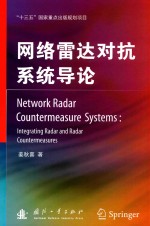图书介绍
网络雷达对抗系统导论pdf电子书版本下载

- 姜秋喜 著
- 出版社: 北京:国防工业出版社
- ISBN:7118106131
- 出版时间:2016
- 标注页数:303页
- 文件大小:35MB
- 文件页数:318页
- 主题词:
PDF下载
下载说明
网络雷达对抗系统导论PDF格式电子书版下载
下载的文件为RAR压缩包。需要使用解压软件进行解压得到PDF格式图书。建议使用BT下载工具Free Download Manager进行下载,简称FDM(免费,没有广告,支持多平台)。本站资源全部打包为BT种子。所以需要使用专业的BT下载软件进行下载。如 BitComet qBittorrent uTorrent等BT下载工具。迅雷目前由于本站不是热门资源。不推荐使用!后期资源热门了。安装了迅雷也可以迅雷进行下载!
(文件页数 要大于 标注页数,上中下等多册电子书除外)
注意:本站所有压缩包均有解压码: 点击下载压缩包解压工具
图书目录
1 Introduction to Network Radar Countermeasure Systems 1
1.1 Introduction 1
1.2 Overview of a Network Radar Countermeasure System 6
1.2.1 Working Principle of a Network Radar Countermeasure System 7
1.2.2 Working Mode of the Network Radar Countermeasure System 11
1.3 Configuration of the Network Radar Countermeasure System 14
1.3.1 Annular Configuration 14
1.3.2 Linear Configuration 15
1.3.3 Zone Configuration 16
1.4 Performance of Network Radar Countermeasure Systems 17
1.4.1 Reconnaissance Detection Area of the Active Mode 17
1.4.2 Reconnaissance Detection Area in Passive Mode 25
1.4.3 Reconnaissance Detection Area in the Integrated Active-Passive Mode 28
1.4.4 Reconnaissance Detection Area in Jamming Conditions 29
1.4.5 Jamming and Suppression Area of the Network Radar Countermeasure System 35
1.4.6 Fuzzy Function in the Mode of Reconnaissance Detection 44
2 Target Positioning of Network Radar Countermeasure Systems 67
2.1 Introduction 67
2.2 Active Mode Target Location 68
2.2.1 Multiple Transmitter One Receiver Mode 68
2.2.2 One Transmitter Multiple Receiver Mode and Multiple Transmitter Multiple Receiver Mode 88
2.3 Target Location in the Passive Mode 114
2.3.1 Acquisition of Location Solution 114
2.3.2 Location Error Analysis 116
2.3.3 Cramér-Rao Bound of Target Location Estimation 117
2.3.4 Simulation and Analysis 119
2.4 Integration of the Active and Passive Modes for Target Location 124
3 Network Radar Countermeasure Systems for Target Recognition 131
3.1 Introduction 131
3.2 Target Recognition with Single Station in Network Radar Countermeasure System 133
3.2.1 The Basic Probability Assignment Calculation of Target Recognition 134
3.2.2 Target Recognition Based on D-S Evidence Theory 139
3.2.3 Single Station Target Identification 143
3.3 Network Center Comprehensive Target Recognition 155
3.3.1 Evidence Weighted Processing of Central Station 157
3.3.2 Recognition Framework Adjustment of Central Station 158
3.3.3 Integrated Identification Example of Central Station 159
4 Target Tracking of Network Radar Countermeasure Systems 163
4.1 Introduction 163
4.2 Target Motion Model 163
4.2.1 Uniform Motion Model 164
4.2.2 Uniformly Accelerated Motion Model 165
4.2.3 Singer Model 166
4.2.4 The Turning Model of Maneuvering Targets 168
4.3 Tracking Filtering Algorithm 169
4.3.1 Information Filter 169
4.3.2 Non-linear Filtering Algorithm 170
4.3.3 Adaptive Filtering Algorithm 174
4.4 Tracking Filter Form 177
4.4.1 Collect Data 177
4.4.2 Centralized Processing Filter Form 178
4.4.3 The Filter Form of Distributed Processing 181
4.5 Joint Probabilistic Data Association Algorithm 184
4.5.1 The Optimal Joint Probability Data Association Algorithm 186
4.5.2 The Simple Joint Probabilistic Data Association Algorithm 190
4.5.3 Associated Algorithm of the Joint Probability Data with the Probability-Weighted Summation Equal to 1 193
4.5.4 Improved Associated Algorithm of the Joint Probability Data 195
4.6 Tracking Multiple Targets by Multiple Receiving Stations 197
4.6.1 The Joint Probabilistic Data Association Algorithm of Parallel Multiple Receiving Stations 197
4.6.2 Joint Probabilistic Data Association Algorithm of Ordered Multiple Receiving Stations 198
4.6.3 Simulation and Analysis 200
5 Network Radar Countermeasure Systems 243
5.1 Introduction 243
5.2 The Pretreatment of a Network Radar Countermeasure System 244
5.2.1 The Space Calibration Network Radar Countermeasure System 244
5.2.2 Time Calibration of the Network Radar Countermeasure System 248
5.3 Hubs Associated Target Track 249
5.3.1 Identity Information Associated with the Target Track 250
5.3.2 Fuzzy Comprehensive Decision of Track Correlation 253
5.3.3 Evidence Track Association Algorithm of Fuzzy Comprehensive Decision 260
5.4 Track Fusion Network Radar Countermeasure System 267
5.4.1 Simple Track Fusion and Cross-Covariance Combination Track Fusion 267
5.4.2 Covariance Intersection Fusion 270
6 Four Countermeasure Capacity Analysis of Network Radar Countermeasure Systems 273
6.1 Network Radar Countermeasure System Anti-jamming Performance Analysis 273
6.1.1 Anti-active Blanket Jamming 274
6.1.2 Resistance to Active Deception Jamming 280
6.2 The Performance Analysis of Network Radar Countermeasure System on Anti-stealth 283
6.2.1 Passive Work Mode for Anti-stealth 284
6.2.2 Selection of Proper Frequency Increasing Anti-stealth Capability 285
6.2.3 Sending and Receiving Allocation and Data Sharing Improve Anti-stealth Capability 286
6.3 Anti-radiation Attack Performance Analysis of a Network Radar Countermeasure System 288
6.3.1 The Advantage of the Network Radar against Anti-surveillance System and Anti-radiation Weapons 288
6.3.2 Anti-destroying Capability Analysis 290
6.4 Network Radar Countermeasure System Against Anti-Low-Altitude Penetration Performance Analysis 294
6.4.1 Bi-static Radar Increasing the Detection Range 294
6.4.2 Passive Detection Improves the Low-Altitude Target Detection Capability 296
Bibliography 299